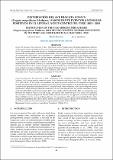Por favor, use este identificador para citar o enlazar este ítem:
https://hdl.handle.net/20.500.12958/3611Registro completo de metadatos
| Campo DC | Valor | Lengua/Idioma |
|---|---|---|
| dc.contributor.author | Ochoa, Manuel | - |
| dc.contributor.author | Bouchon Corrales, Marilú | - |
| dc.contributor.author | Quiñones, Javier | - |
| dc.date.accessioned | 2021-10-20T00:44:18Z | - |
| dc.date.available | 2021-10-20T00:44:18Z | - |
| dc.date.issued | 2021-07 | - |
| dc.identifier.citation | Ochoa M, Bouchon M, Quiñones J. 2021. Distribución del ave fragata común (Fregata magnificens Mathews, 1914) durante eventos anómalos positivos en el litoral norte centro del Perú. 2015 - 2019. Bol Inst Mar Perú. 36(1) 44-53 | es_ES |
| dc.identifier.issn | 04587766 | - |
| dc.identifier.uri | https://hdl.handle.net/20.500.12958/3611 | - |
| dc.description.abstract | El presente trabajo está basado en el análisis espacio-temporal del ave fragata (Fregata magnificens) relacionado a temperatura y salinidad superficial del mar y el índice ICEN, mediante el análisis multivariado de componentes principales, cuya respuesta es la distribución espacio temporal de la especie, explicando la asociación de la distribución con los eventos anómalos positivos El Niño 2015-2016 y El Niño Costero 2017. El área de estudio comprendió desde 4°S al norte de Paita hasta 12°S frente a Callao, de octubre 2015 a diciembre 2019. A la especie se observó hasta 7°S, relacionado con la intromisión de Aguas Ecuatoriales Superficiales (AES) desde el norte y al acercamiento de las Aguas Subtropicales Superficiales (ASS) desde el oeste hasta 20 mn de la costa. La importancia de la distribución espacio-temporal del ave fragata radica en la evidencia de que se trataría de un indicador biológico ante el calentamiento progresivo de las aguas superficiales y el ambiente durante eventos anómalos como El Niño. | - |
| dc.description.abstract | ABSTRACT: In this work, we considered the spatio-temporal analysis of the magnificent frigatebird (Fregata magnificens), based on sea surface temperature and salinity, together with the ICEN index. Therefore, a multivariate principal component analysis was performed, whose response is the spatio-temporal species distribution, which would explain the association of such distribution with the positive anomalous events of El Niño 2015-2016 and El Niño Costero 2017. From October 2015 to December 2019, we studied the area between 4°S north of Paita to 12°S off Callao. The species was observed up to 7°S, which was related to the intrusion of Surface Equatorial Waters (SEW) from the north and the approach of Surface Subtropical Waters (SSW) from the west up to 20 nm offshore. The importance of the spatio-temporal distribution of the magnificent frigatebird lies in the evidence that it would be a biological indicator of the progressive warming of surface waters and the environment during anomalous events such as El Niño. | - |
| dc.language.iso | spa | es_ES |
| dc.publisher | INSTITUTO DEL MAR DEL PERÚ | es_ES |
| dc.relation.ispartofseries | Boletín IMARPE 36(1), 2021; | - |
| dc.rights | info:eu-repo/semantics/openAccess | es_ES |
| dc.rights.uri | https://creativecommons.org/licenses/by/4.0/ | es_ES |
| dc.source | Instituto del Mar del Perú - IMARPE | es_ES |
| dc.source.uri | Repositorio Digital IMARPE | es_ES |
| dc.subject | Fregata magnificens | es_ES |
| dc.subject | Ave fragata | es_ES |
| dc.subject | El Niño | es_ES |
| dc.subject | Perú | es_ES |
| dc.title | Distribución del ave fragata común (Fregata magnificens Mathews, 1914) durante eventos anómalos positivos en el litoral norte centro del Perú. 2015 - 2019 | es_ES |
| dc.title.alternative | Distribution of the magnificent frigatebird (Fregata magnificensMathews, 1914) during positive anomalous events in the Peruvian north-central coast (2015 - 2019) | es_ES |
| dc.type | info:eu-repo/semantics/article | es_ES |
| dc.publisher.country | Perú - Callao | es_ES |
| dc.subject.ocde | http://purl.org/pe-repo/ocde/ford#1.06.12 | es_ES |
| Aparece en las colecciones: | Boletín 36(1), 2021 | |
Ficheros en este ítem:
| Fichero | Descripción | Tamaño | Formato | |
|---|---|---|---|---|
| Boletin 36-1 articulo3.pdf | 1,58 MB | Adobe PDF |  Visualizar/Abrir |
Este ítem está sujeto a una licencia Creative Commons Licencia Creative Commons

